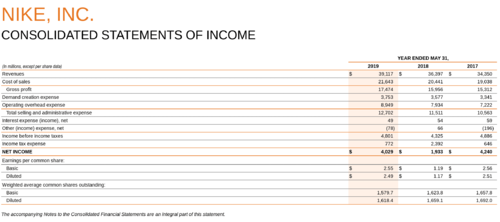Above the Line
Above the Line refers to all revenue generated and expenses incurred by a business that have a direct impact on reported profits. In effect, the term includes all activity reported on an organization's income statement. The term does not refer to other activity that only impacts the financing or cash flows of the business. For example, the receipt of funds from the sale of company stock is not considered to be above the line. Conversely, the sale of goods and the associated cost of goods sold are considered to be above the line. A different interpretation of the concept is that "above the line" refers to the gross margin earned by a business. Under this interpretation, revenues and the cost of goods sold are considered to be above the line, while all other expenses (including operating expenses, interest and taxes) are considered to be below the line.[1]
Example of Above-the-Line Costs[2]
As an example, Nike Inc. reported $39.1 billion in sales in its fiscal year 2019. Gross profits were $17.5 billion. Therefore, Nike's above-the-line costs for the quarter were $21.6 billion, which the company labels cost of sales on its income statement
Also consider Expedia Inc., the travel website, which reported $3.2 billion in revenue in its second quarter of 2019 and an operating income of $265 million. The company is not involved in the production of goods so the company does not use gross profit as a metric in its income statement.
All expenses before operating income are considered above-the-line costs for Expedia, including the cost of revenue and selling and marketing expenses, among others.
- ↑ Definition - What Does Above the Line Mean? Accounting Tools
- ↑ Example of Above-the-Line Costs Investopedia


